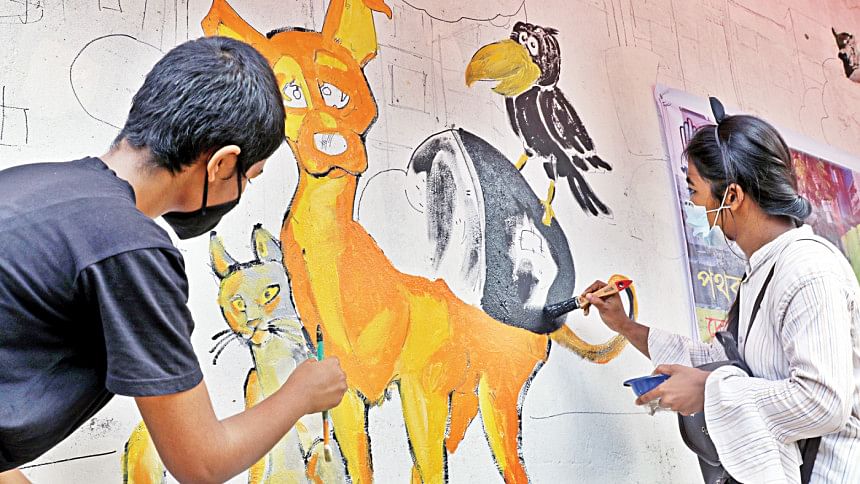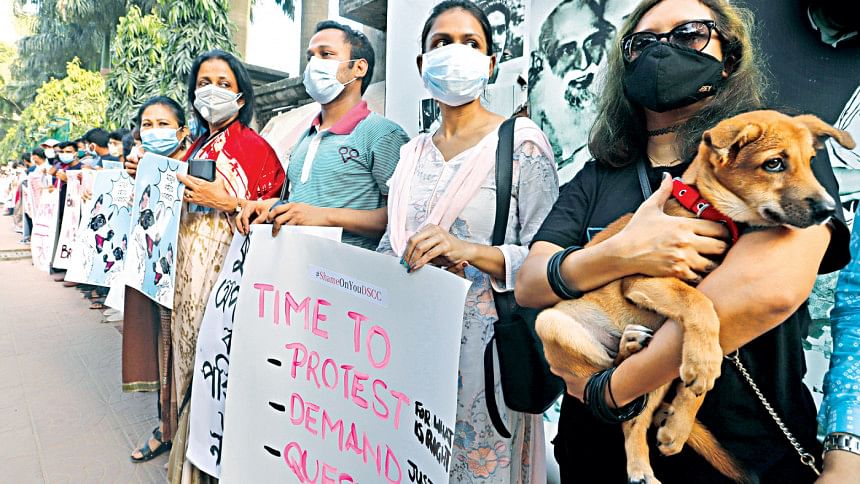Why relocation of stray dogs is not the right way to go about it

In mid-August, Dhaka South City Corporation declared to start a programme of relocating the 30,000 stray dogs of the city to other districts to contain the spreading of rabies, but primarily to selected areas from Nagar Bhaban, Dhanmondi and other VIP areas. However, DSCC started relocating the stray dogs before the official order came from the Mayor, and relocated 15 stray dogs on an experimental basis from the Nagar Bhaban and VIP areas of South Dhaka to the Matuail landfill in a 3-day long relocation process. This was followed by protests from animal rights activists and animal lovers in general, who were against this move since the beginning. A group of activists from six animal welfare organisations and some volunteers held a human chain in front of the Nagar Bhaban to protest this relocation process on September 2.
More than 2000 people and a large number of animals die of Rabies every year in Bangladesh, of which 98% of the human deaths are due to bites from rabid dogs. But only 6 per cent of all dogs in Bangladesh have rabies. And 70 per cent of the stray dogs of the city have already been vaccinated against rabies in the first round of a health ministry project to eradicate the disease within 2022. Some 48,000 dogs were vaccinated in 2019, of which 28,000 were from the DSCC area alone. The second round of vaccination has stopped due to the Coronavirus pandemic. If the dogs are relocated without vaccination, the risk of rabies infection in Dhaka South will rise, mostly because other dogs will occupy the areas if the old ones are relocated. Under these circumstances, is it the right move to relocate the stray dogs to other areas?

Rubaiya Ahmad, founder and chairman, Obhoyaronno- Bangladesh Animal Welfare Foundation said, "First of all, this relocation process cannot be the right way to deal with the issue because it is illegal. Most importantly, it is unscientific to relocate stray dogs from their habitat. Most of these dogs are vaccinated and vaccinated dogs act as soldiers against rabies. If we relocate them, other unvaccinated dogs will fill in their places, causing it to spread more widely. Relocation is also wrong from a humanitarian ground, we just cannot take their homes away from these animals."
Artist and Activist Saria Saguaro said, "Relocating the stray dogs is not going to solve anything. When we relocate them, they don't get enough food to go by, fight with other territorial dogs causing even more havoc. And as per the last update, the relocated dogs have started to come back to their previous habitat, so it's clearly not working."
How Bangladesh has been dealing with stray dogs: Animal laws and enactment
The inhuman practice of dog culling had been a regular phenomenon in the country in an attempt to control the stray dog population until January 2012, when the government declared Dhaka as the country's first "no-cull" city. The Parliament of Bangladesh enacted the new Animal Welfare Act of 2019, replacing the old Cruelty to Animals Act of 1920. This new act contains a more comprehensive reckoning of cruel and unjust treatment of animals and substantially raises the penalty for the same, while also keeping room for further elaboration through rules and gazettes. This law is a substantial leap forward in the recognition of the need to treat animals with kindness.

The new act prohibits anyone from killing or moving any stray animal from its habitat. According to section 7 of the Animal Welfare Act, 2019 the killing or removal of stray animals is not allowed unless they are proven to be causing harm. If a government body does it, then any aggrieved organisation and person can avail their constitutional right to file a writ petition with the High Court. This makes the relocation process of the DSCC stray dogs illegal as per the constitution of the country.
How other countries deal with stray dogs
The World Health Organisation estimates there are around 200 million stray dogs worldwide. Impressively, the Netherlands is not contributing to this statistic. It has become the first country in the world without any stray dogs. Owning dogs used to be a sign of status in the Netherlands. Upper-class people owned dogs for pets or sporting purposes, and the poorer masses owned mongrels (mutts) for working purposes. In 1864, the first animal protection agency was set up in The Hague. A century later, the Animal Protection Act came into force. Now, it is forbidden for an owner to abuse any animal. They implemented the CNVR programme (Collect, Neuter, Vaccinate, and Return), which is a nation-wide, government-funded sterilisation programme. The World Animal Protection Agency believes it is the most effective way to combat a stray dog population. The Netherlands has also set up an animal police force to monitor crimes against animals, including rescue animals in trouble.

In Bali alone, the number of stray dogs is estimated at 500,000 and a rabies epidemic underway since 2008 has already killed 78 people. Despite culling somewhere between 120,000 and 200,000 dogs, and vaccinating an estimated 262,000 dogs, the epidemic rages on. In the face of the continuing epidemic and shortages of human anti-rabies vaccines, the government had banned dogs from the streets altogether -- perhaps the first at-large law imposed in this part of the world. The stray dog-driven rabies crisis in Bali is hardly unique: India culls as many as 100,000 strays at a time, while attacks by marauding packs of dogs in Baghdad have led to a reinstitution of the same eradication program of culling over one million stray dogs.
At the same time, animal shelters and dog rescue groups are springing up throughout Asia, Eurasia, the Middle East, parts of Latin America and the Caribbean. Some jurisdictions, notably Shanghai and Singapore have built pounds to hold strays, while in other locales, private citizens have formed humane societies and loose-knit groups of volunteers to care for rescued dogs.
When asked whether it's feasible to implement these measures in our country, Rubaiya Ahmad said, "I believe so. With proper support and resources, it is very much feasible."
"I think what we are lacking in is the proper training of vets and dog catchers to implement these measures. The quality of work can surely be increased with proper training facilities, and that way better service can also be ensured", said Saria Saguaro.
CNVR: The right way to control the crisis
Conducting a count of the dog population stray and pets with emphasis on area-wise distribution is a priority in dealing with stray dogs. Based on this count, efforts can be made to initiate a Collect Neuter Vaccinate and Return (CNVR) project and keep a count on the number of dogs vaccinated and those left stray in a particular area. This will help reduce and maintain the population in the heavily populated areas, in a more effective manner than relocation or culling.
CNVR is a quick and efficient way to manage community dogs. When done using modern surgical techniques and materials, it does not require days of sheltering for recovery before the animals can be released safely back to their territories or their owners. Usually, the animals can be released the same day, with no further treatment required, and without requiring sheltering during recovery, which is the logistical weak link of non-same-day release methods.

"We need to take a more humane approach while dealing with this particular issue. We have to think of a long-term plan and do what the other countries are doing, like sterilising, neutering and vaccinating the strays. That is certainly the right way to go about this", said Saria Saguaro.
It's worth noting that, at present, Obhoyaronno already conducts its CNVR programs in partnership with DNCC in North Dhaka, which raises the question about the requirement of relocating or culling dogs even more strongly.
Latest update: Present-day situation in Dhaka
Meanwhile, Dhaka North City Corporation has decided on not following in the footsteps of DSCC. DNCC is going to control the number of stray dogs by sterilising stray dogs and reduce the rate of infection by strengthening the ongoing vaccination program. Brigadier General Mohammad Mominur Rahman Mamun, chief health officer of DNCC stated that as the High Court prohibited both killing and transferring the dogs, they are going to strengthen the ongoing sterilization and vaccination program with Obhoyaronno, an NGO and DGHS. If this is possible for one half of the city, why not the other half?

As for now, the final decision is yet to be taken by Barrister Sheikh Fazle Nur Taposh, Mayor of DSCC. Rubaiya Ahmad said, "As the Mayor is a man of law, we are hoping that he will not go against the laws of the country and implement such an illegal act of relocating the stray dogs."
"Deciding to relocate the stray dogs will be a step backwards when there are better alternatives, and it is also illegal in the country. We all want what's good for the city. The way forward will be to come to an understanding. I think initiating a conversation will also help the authorities understand the ethical and moral point that we're trying to make. Not relocating the stray dogs is certainly going to be a popular decision among the next generation of citizens, as they are better aware of the facts regarding the issue", said Saria Saguaro.





Comments